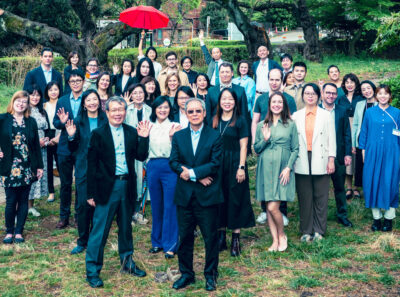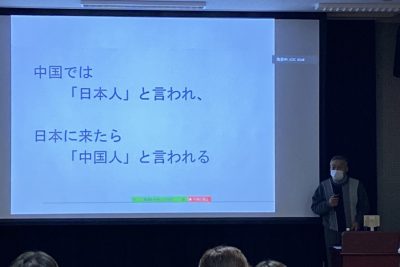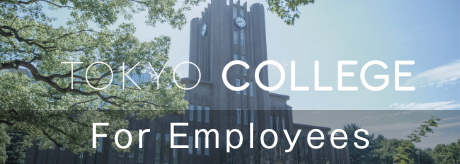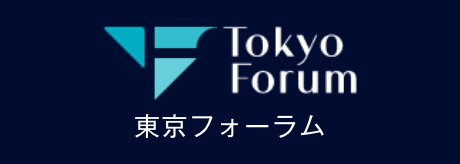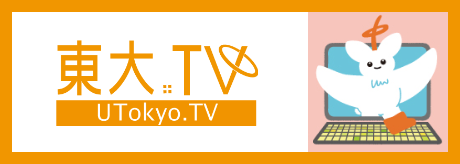Launching the New Series, “Ethnographies of Life and Work” : Researchers
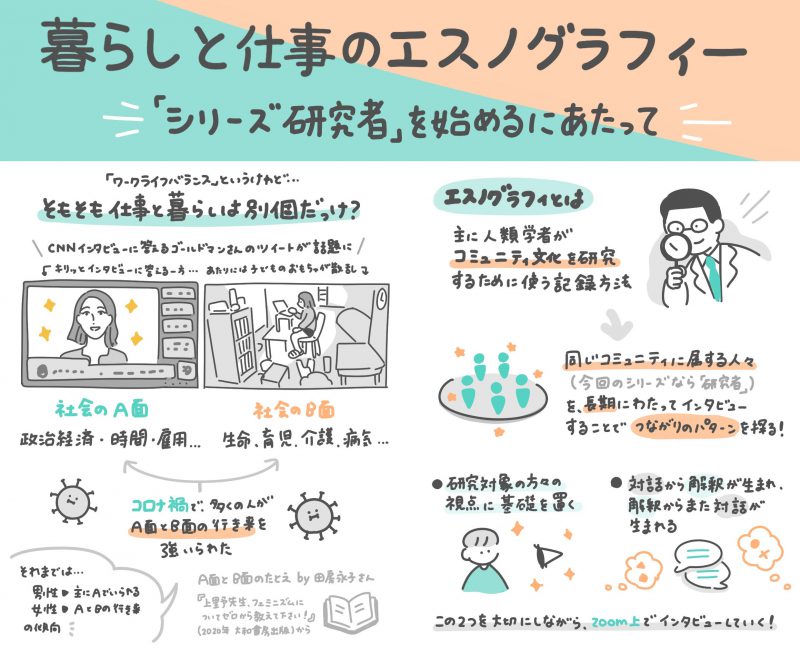
Graphic Recording ©Innovation Team dot Moe Ikeda
We often hear the phrase “work-life balance,” but are “work” and “life” really separate things?
The coronavirus pandemic is making work-from-home the new normal. University researchers are no exception. Currently, many members of the University of Tokyo faculty are conducting classes and research from home.
Scenes of work in the midst of everyday life are starting to become familiar.
The tweet sent by Gretchen Goldman, a scientist, has sparked much discussion. The tweet was about her interview with CNN on September 15, 2020, which was conducted remotely from her home. Dressed in a suit jacket, Dr. Goldman, as she appeared on CNN, was the picture of professionalism. However, outside of the field of view, the room was cluttered with the toys of her two children, aged 2 and 4. From the picture, we can well imagine Gretchen playing with her children right up until the interview and scrambling to throw on a jacket at the last moment.
Just so I'm being honest. #SciMomJourneys pic.twitter.com/4yZMKtVxwP
— Gretchen Goldman, PhD (@GretchenTG) September 15, 2020
Dr. Goldman’s tweet titled “Just so I’m being honest” quickly went viral, receiving more than 300,000 retweets and 2.8 million “likes” in a single day from readers for whom the scene was all too familiar.
As is evident from the very term “work-life balance,” up to this point, we have treated “work” and “life” as separate things and have sought to achieve better balance between the two. However, the coronavirus pandemic has, in an instant, tossed the two together into a blender.
Or, perhaps, the two have always been intermixed. Only, up to now, life has remained hidden in the shadow of work as result of our gendered social structure.
Manga author Eiko Tabusa’s explanation of society in terms of an A-side and a B-side in Ueno-sensei, feminizumu nituite zero kara oshiete kudasai! [Prof. Ueno, Please Teach Us about Feminism from Scratch!] (2020, Daiwashobo) has sparked much interest.
I believe that society has an A-side and a B-side. Things like the politics, economy, time, and employment are part of society’s A-side. The B-side includes things like reproduction, care for the aged and children, illness, disability…Men live on the A-side. Women also start out living on the A-side but are forced to go to the B-side when they have children. Men can also be forced to switch sides by illness or injury; but, as a general rule, they are able to stay on the A-side. Women have to move back and forth between the A-side and the B-side. For example, they may be told by a hospital on the B-side that they are “at risk of having a miscarriage and need to have a break from work,” setting up a struggle to make arrangements with their employer on the A-side.
(Source: Prof. Ueno, Please Teach Us about Feminism from Scratch!)
Dr. Goldman’s interview brings into full view the reality of women who have to move back and forth between the A-side (photo on left) and the B-side (photo on right).
“Work,” which exists on the A-side, is generally seen as being official—something that requires perfection, no ambiguity or vulnerability, and, in most cases, a certain extraordinariness. From the standpoint of such work, at first glance, “life,” which exists on the B-side, might appear to be private—something more fluid, where messiness, ordinariness, vulnerability, and, at times, contradiction, are par for the course.
That said, our lives—which include our homes, families, leisure, and so on—exist in the same space as work and affect the way we work in unexpected ways.
The coronavirus pandemic has forced many people, not just women, into a situation where they have to move back and forth between the A-side and the B-side. As we struggle to find a new normal, it seems that it is meaningful to rethink the relationship between the A-side and the B-side from the perspective of “life.”
This interview series was planned with the goal of understanding life and work not as being separate as we have done in the past but, rather, as processes that are intertwined in time and space. Our hope is to shine a new light on the value system represented by “work-life balance,” which people living in contemporary society have sought to achieve. We will challenge the propriety of seeing work and life as separate things, which lies at the root of this value system.
In the first instalment of this series, we focus on a segment of society that should be very familiar to all of us—“researchers”—and explore how work (A-side) is intermingled with life (B-side). Specifically, we have asked well-known researchers from the University of Tokyo and other institutions to select three photographs that represent “life.” Junior scholars at the Tokyo College will invite our guest to share stories over these photographs, including those topics that were not covered in the images. It is our hope that doing so will bring to light unexpected connections between work and life.
We plan to employ ethnographies, which are used by anthropologists when studying a community, to document the contents of the interviews. Ethnographic research generally entails long-term participant observation of a given community. Anthropologists typically embed themselves in the field and live among the people that they are working with. The current coronavirus pandemic makes such immersive investigation difficult. Instead, Zoom has become the field. In this project, instead of long-term participant observation of individual guests, we hope to discover patterns of work-life connections by conducting long-term observation of people who belong to the same professional group. Although we plan to retain the basic principles and approaches of ethnography such as the “centrality of the vantagepoint of interlocutors” and “dialogue leading to interpretation, which in turn leads to further dialogue,” it remains to be seen whether such methods will prove effective. In this sense, this project can also be said to be an experiment to explore “new research methods” in the context of the new normal.
As we try to figure out how we are going to work and live in the future, another thing that is important is the vantagepoint of younger generations. In this project, the plan is to have a team of university undergraduate students act as graphic recorders to capture discussions between junior scholars of the Tokyo College and the invited guests. It is possible that the ethnographies written by junior scholars and graphic recordings created by the student team will tell very different stories, even when they are of the same discussion. Such differences themselves can provide new insights that cut across generations.
The ethnographies and graphic recording will be published as blog posts on the Tokyo College website. The first instalment of the “Ethnographies of Life and Work” series is scheduled to be published next month. It would be our greatest joy if the discussions with our invited guests, captured in ethnographies and graphic recordings, serve as an opportunity to take a fresh new look at connections between life and work.


